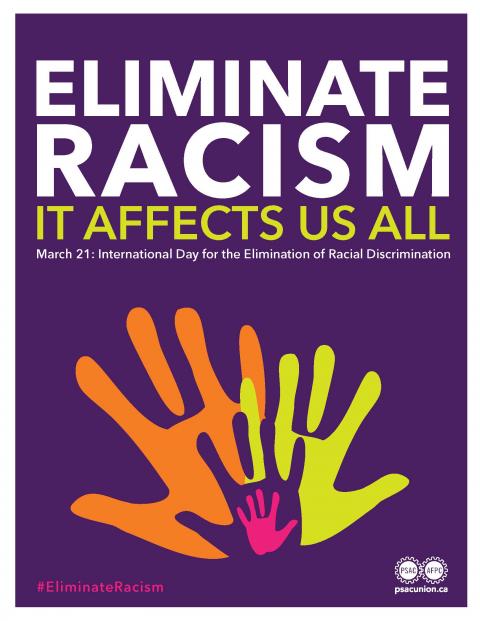In 1966, the United Nations proclaimed March 21st as the International Day for the Elimination of Racial Discrimination.
While there has been some progress with respect to racial justice, racism persists in Canadian society, there has also been some erosion of human rights over the past decade.
2011 National Household Survey
The 2011 National Household Survey reaffirms what previous census have shown. According to the survey:
- 19.1% of the total population in Canada identify as “visible minorities” or racialized
- Overall, the racialized population has a higher percentage of university degrees than the non-racialized population
- Yet, racialized workers are under-employed, and the unemployment rate among the group is higher than non-racialized workers
- Racialized people in Canada make 21% less than the average income of non-racialized people.
Forms of racial discrimination
Racialized people continue to be under-represented at decision-making levels in various sectors including, but not limited to, the workplaces, the media, the criminal justice system and the political arena.
On the other hand, when racialized communities are portrayed in public realms, they are often portrayed negatively and stereotyped into particular categories, such as a gang member, a terrorist, etc.
Workplace racial discrimination or racism can be overt or subtle. It can occur during the hiring process. Some examples of these include racialized applicants being:
- deemed not having the “experience” or qualifications required
- deemed not being the right “fit” for the organization or
- evaluated by the selection board with implicit biases toward the particular applicant.
Racial discrimination can also occur when determining, for example:
- who gets the “acting” or training opportunities or
- who is included or isolated or
- whose contributions are recognized credited at meetings or events.
Racialized workers also experience wage and occupational discrimination. An example of occupational discrimination is when racialized workers are not given the work or positions that match their qualifications and experience.
Racialized workers may also experience many micro-aggressions on a daily basis (e.g. negative comments about their food, culture, appearances, etc.), often based on stereotypes and prejudices.
Impact of racial discrimination
The consequences of racial discrimination can be profound. In 2013, the Diagnostic and Statistical Manual of Mental Disorders-5 (DSM-5) recognized that race-based trauma can cause PTSD (post- traumatic stress disorder) due to racism on emotional and psychological well-being. The DSM-5 is the leading authority used by psychiatrists and psychologists in mental health related disabilities.
PSAC Regional Conferences for racially visible members
In order to better understand and support the issues faced by racialized members across the country, the 2015 PSAC Triennial Convention passed a resolution that called for regional conferences for racially visible members. These inaugural regional conferences will take place this calendar year.
This March 21, the PSAC calls on all members to stand in solidarity with racialized communities and to continue the struggle for social justice and human rights. The PSAC encourages members to hold events that raise awareness of racism and racial discrimination.
 Member Login
Member Login



